ARE YOU LISTENING?
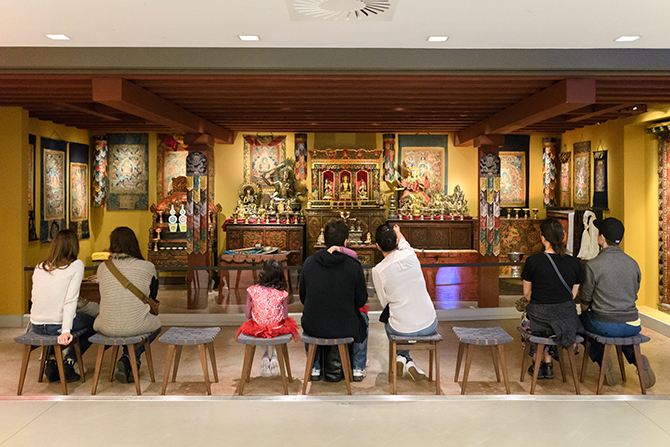
Filip Wolak Losar Family Day
By Joan Hornig
Come November in NYC there is no hiding from the flurry of activity and the sounds of a city at work and in pre-holiday mode. We start to hum the holiday tunes without even thinking about it. Many of us plan and attend seasonal musical activities like The Nutcracker, The Messiah, Radio City Holiday Spectacular, Broadway musicals and other traditions. But how many of us think to go to an art museum for Sound Art exhibitions?
Apparently, many. I say this because 3 of our most influential art museums—The Guggenheim Museum, Museum of Arts and Design (MAD), and the Rubin Museum of Art—have devoted attention and exhibitions to this artistic discipline in which sound is utilized as a primary medium in contemporary art.
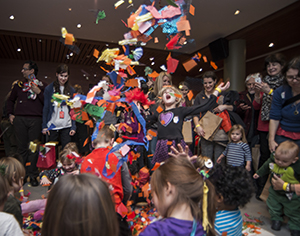 Michael Palma
Michael PalmaWhile Sound Art may be relatively new to some, it is commanding increased attention around the world and has many roots in our city through a history of exhibitions devoted to it in our top cultural institutions. The first decade of this century saw at least 130 Sound Art exhibitions worldwide which can be attributable to both advances in technology as well as the desire to push the boundaries of art.
The earliest documented use of the term “Sound Art” in the U.S. began in 1983 with a show called Sound/Art which was held at the Sculpture Center in NYC created by William Hellerman. In 2013, MoMA held the first-ever major exhibition dedicated to Sound Art, paving the way for its acceptance and prominence in museums and galleries around the world.
Sound Art is by its nature interdisciplinary and takes on hybrid forms. It can engage with a range of subjects such as acoustics, psychoacoustics, electronics, noise music, audio media, and environmental sound, explorations of the human body, sculpture, architecture, film or video. Because of the diversity of Sound Art, some consider it visual art or experimental music or both. But as the artist or the curator and all would agree that the conjunction of sound and image insists on the engagement of the viewer, forcing participation in real space. And, isn’t this just what our current museum audience wants and is demanding as technology plays a greater and more important role in our lives?
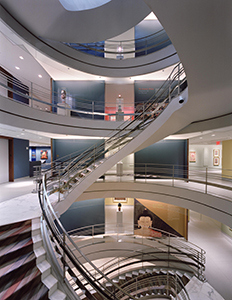 Photograph by Peter Aaron Esto
Photograph by Peter Aaron EstoTHE GUGGENHEIM MUSEUM
The Guggenheim Museum began this recent trend with the summer exhibition of Doug Wheeler’s 50 years in the making installation of PSAD Synthetic Desert III. An immersive, completely silent “desert” meant to have viewers feel complete and total silence. He accomplished this employing semi-anechoic chambers (used by scientists and manufacturers to conduct acoustical experiments) combined with special lighting which evokes an endless space. Ironically, most people can’t endure this profoundly empty soundscape for more than 40 minutes!
For more information on The Guggenheim Museum, visit guggenheim.org.
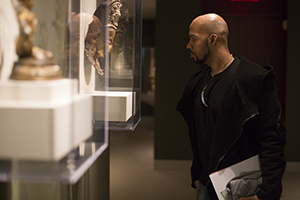 Asya Danilova
Asya DanilovaMUSEUM OF ARTS AND DESIGN
Museum Of Arts And Design’s The Sonic Arcade: Shaping Space with Sound on Columbus Circle is the opposite of silent with most of the museum devoted to interactive installations, immersive environments, and performing objects that explore how the ephemeral and abstract nature of sound is made material. It embraces the physical and material nature of sound through a combination of large-scale works that seek to engage space, architecture and the movement of the body through space using projects that utilize electronics and new technology as tools and material.
The show, two years in development, features six solo exhibitions and two “group” exhibitions. Some of the exhibits were commissioned, others reconfigured to be site specific. But whether your taste is grand or intimate, you are young in age or heart; there is something for you, your family and friends. Just come prepared to spend some quality time at MAD. The Studio PSK Polyphonic Playground brought here from the UK is perfect for any inclement weather day. You can climb, swing and make music while becoming your own performance artist. Just bring your cell phone to Instagram and Snapchat the expressions of delight you will witness.
On a smaller scale, but equally compelling, is the jewelry by Noordemean and Wright: Audiowear exhibit. MAD has the only permanent museum jewelry gallery in the US, and this installation allows visitors to interact with jewelry even when behind glass cases.
For more information on The Museum of Arts and Design (MAD), visit madmuseum.org.
RUBIN MUSEUM OF ART
Rubin Museum Of Art, as locals and visitors will agree, is one of the best things about NYC. For the price of a subway ride, you can find yourself immersed in other cultures. The Rubin, known for its innovative programming and community outreach connecting the art and culture of the Himalayas and neighboring countries throughout history, has a major exhibit called The World is Sound. This show explores how sound and our sense of hearing shape our daily lives, traditions, history and all of the existence by employing sound in new ways to animate and intensify the experience of art in The Rubin’s collection. Organized cyclically from creation to death to rebirth, the exhibition explores different dimension of sound and listening and its many functions in Tibetan Buddhism.
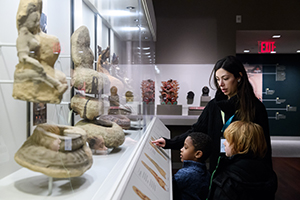 Filip Wolak Family Day
Filip Wolak Family DayLike the MAD exhibition, many artists are incorporated into the show; some galleries showcase site commissioned work and others exhibit some of the most prominent contemporary sound artists juxtaposed to historical objects from the museum’s collection. Also like the MAD exhibition, the gallery space itself becomes an instrument of transformation, using the stairways to continue the experience. Ambient drone sounds inspired by Buddhist philosophy are “tuned” to the building and ascend and descend as visitors wind their way up the Rubin’s iconic spiral staircase. The subtlety and ephemerality of the sounds prepare the listener for understanding that in the Buddhist philosophy, music is a metaphor for change and impermanence.
This is another exhibit you should not rush through or attend only once to garner its full impact. Instead, take a moment to understand some of the most important Buddhist tenants: Slow down, consider your bodily engagement with sound, space, and your individual perceptions. If you need a little coaching on how to experience these things, there are a series of public programs and an audio tour available (rubinmuseum.org).
Sound Art is having its moment with a large number of artists exploring sound in its pure state, simultaneously bridging and muddling barriers between sound, noise, and music in the contemporary or historical sense. It’s also the most direct way of engaging with art—you can literally do it with your eyes closed, and if music is any indication, sound can affect your emotions immediately, without any thought or explanation. But don’t close your eyes and instead, open your ears to the opportunities available right here in NYC to indulge in the hottest emotive medium this season!
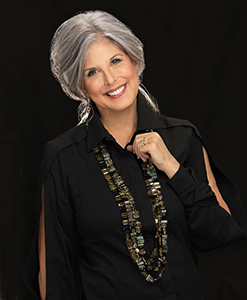
Joan Hornig is a New York-based Jewelry Designer, Social Entrepreneur, and Philanthropist. She left a Wall Street career 15 years ago to create a jewelry line at Bergdorf Goodman, where 100 percent of her profit is donated to the charity of the purchaser’s choice.



